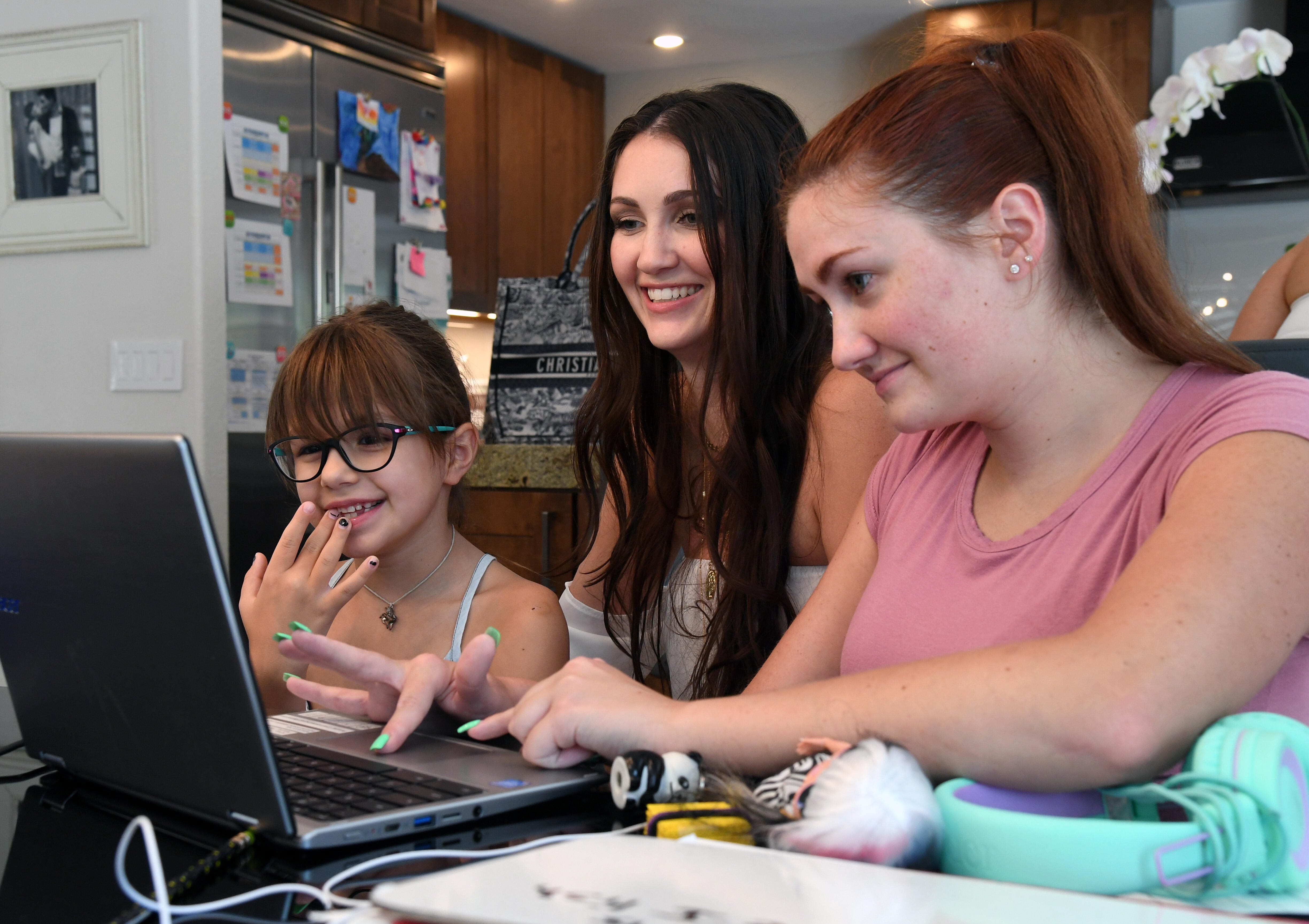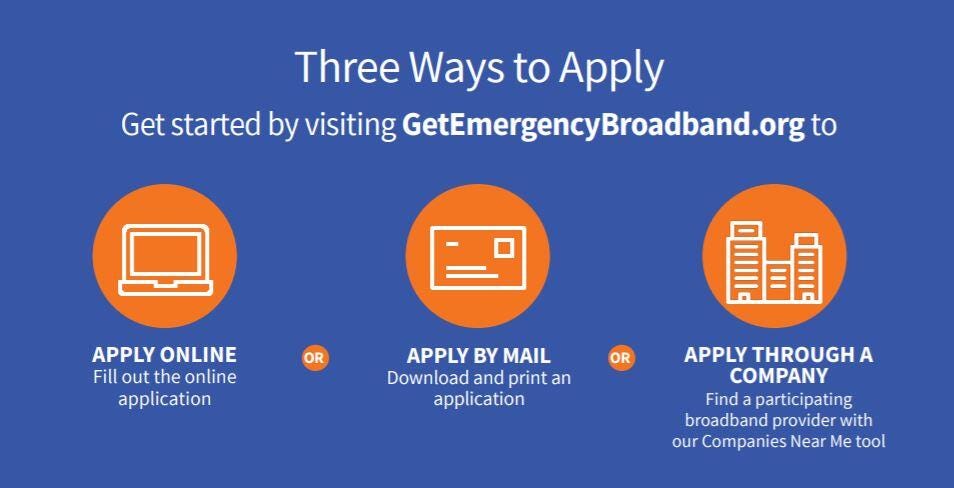[ad_1]

Remote learning, telehealth, online socializing and more pandemic-era norms have pushed our internet usage to the max.
Ethan Miller/Getty Images
The ongoing pandemic has made the importance of a dependable broadband connection at home abundantly clear, but broadband isn’t always easy for Americans to afford. The Federal Communications Commission wants to help with a new subsidy program called the Emergency Broadband Benefit. Those who qualify can sign up now to receive $50 off their monthly internet bill, among other benefits.
Hundreds of broadband providers have committed to participate in the program, including AT&T, CenturyLink, Charter Spectrum, Comcast Xfinity, T-Mobile, Verizon and others, so there’s a good chance it’s available in your area. Here’s how to tell if you qualify, how you can enroll, and everything else you should know.
We need to get 100% of us connected in this country and the Emergency Broadband Benefit Program is an essential part of making that happen. This program provides monthly discounts on #broadband services to eligible individuals and it starts TODAY.https://t.co/PuPyRSSti7
— Jessica Rosenworcel (@JRosenworcel) May 12, 2021
Step 1: Determine your eligibility
The Emergency Broadband Benefit isn’t open to everyone. Eligibility is limited, so you’ll need someone in your household who qualifies in order to opt in.
There are several ways to qualify. The first is income-based. Any household with an income less than or equal to 135% of federal poverty guidelines qualifies. That figure is weighted by the number of people who live in your home and also by where you live, as the poverty line is set higher in Alaska and Hawaii than it is in the 48 contiguous states. Here’s how those numbers look in chart form:
Emergency Broadband Benefit: Qualifying income levels
| Number of people in household | 48 contiguous states, DC and territories | Alaska | Hawaii |
|---|---|---|---|
| 1 | $17,388 | $21,722 | $20,007 |
| 2 | $23,517 | $29,390 | $27,054 |
| 3 | $29,646 | $37,058 | $34,101 |
| 4 | $35,775 | $44,726 | $41,148 |
| 5 | $41,904 | $52,394 | $48,195 |
| 6 | $48,033 | $60,062 | $55,242 |
| 7 | $54,162 | $67,730 | $62,289 |
| 8 | $60,291 | $75,398 | $69,336 |
| For each additional person, add: | $6,129 | $7,668 | $7,047 |
If you make more than that, you may still be eligible. Anyone who experienced a “substantial loss of income” after Feb. 29, 2020 qualifies so long as their 2020 income was at or below $99,000 for a single filer or $198,000 for joint filers.
Additionally, your home qualifies if anyone in your household:
- Qualifies for Lifeline benefits through participation in SNAP, Medicaid, Supplemental Security Income, Federal Public Housing Assistance or Veterans and Survivors Pension Benefit.
- Received a federal Pell Grant in the current award year.
- Received approval for benefits under the free and reduced-price school lunch program or the school breakfast program in the 2019-20 or 2020-21 school year.
- Meets the eligibility criteria for an FCC-approved provider’s existing low-income or COVID-19 program.
Eligibility also extends to any household participating in one of a number of tribal-specific assistance programs, including Bureau of Indian Affairs General Assistance, Tribal Head Start and Tribal Temporary Assistance for Needy Families. If your home is on qualifying tribal lands, the benefit goes up to $75 per month instead of $50.
Read more: Could your state secretly owe you money? How to find out for free
Internet providers in your area
Step 2: Obtain proof of eligibility
You’ll need to demonstrate your eligibility for the program when you apply, so be prepared to gather a document or two. Specifically, you’ll need to show proof of your stated income, such as a pay stub or a tax return. If you need to show a loss of income, you’ll also need to offer a termination letter, an application for unemployment benefits, a furlough notice or something similar.
Eligible by way of another program, like a Pell Grant or reduced-price school lunches? Be prepared to show a card, letter or other official document as proof of participation when you apply.
For more guidance on what sort of documents will work best for proving eligibility, click here.

Screenshot by Ry Crist/CNET
Step 3: Choose how to apply
You’ve got a number of ways to apply for the Emergency Broadband Benefit — and in some cases you might not need to apply at all. For example, current enrollees of the Lifeline program don’t need to reapply, and can skip ahead to step 4. The same goes for some people who are already enrolled in an existing low-income or COVID-19 assistance program with their internet provider, so long as the provider obtained approval for its application process from the FCC.
Those who do need to submit an application will be able to do so online starting today. You can also print out an application, fill it out and send it along with proof of eligibility to the following address:
Emergency Broadband Support Center
P.O. Box 7081
London, KY 40742
On top of that, participating internet providers should be able to answer your eligibility questions and guide you through the application process. And, speaking of which…
Step 4: Talk to your internet provider
Once you submit your application, you should expect a timely reply. In fact, the FCC says that those who apply online may receive immediate approval. If the FCC’s system can’t immediately determine proof of eligibility, it’ll request additional documentation and provide instructions as to how to submit those documents for review.
Either way, once you’re approved, you’ll want to give your internet provider a call, inform them of your enrollment, and ask them what plans are available at a discount. The FCC’s website features a free tool to help find qualifying providers in your area — you can access it by clicking here.
What else should I know?
For starters, it’s important to remember that this is a temporary program, so the $50 discount on your internet bill won’t last forever. The program will end once it runs out of money, or six months after the Department of Health and Human Services declares an end to the COVID-19 health emergency, whichever comes first. At that point, you’ll need to agree to pay the regular rate for your internet plan if you want to keep using it.
The program’s other key benefit is a one-time, $100 discount on a laptop, tablet or desktop PC. There aren’t a lot of details posted yet about how that discount works or which devices are eligible, but you’ll need to pay a co-pay of between $10 and $50 in order to receive the discount, depending on the device. I’ve reached out to the FCC for more information on that benefit, and I’ll update this post when I hear back.
If you have additional questions about the Emergency Broadband Benefit, you can email EBBHelp@usac.org, or call 833-511-0311 any day of the week between 6 a.m. and 6 p.m. PT (9 a.m. to 9 p.m. ET).
[ad_2]
Source link